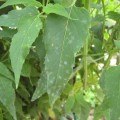Since this is one of the few greens that I actually like when cooked, I decided to try growing it this year.
Botanical Information
Taxonomy
- Brassica oleracea acephala
History
- until the Middle Ages, kale was one of the most common green vegetables eaten in Europe wikipedia
- considered to be the most primitive members of the cabbage family
- originated in eastern Mediterranean area and Asia Minor
Physical Description
- green or purple leaves in which the central leaves do not form a head, like other brassica greens
Varieties & Cultivars
Categories or Types of Kale
Classification is done usually by leaf type:
- Curly-leaved (Scotch types, Scots kale; blue curled kale)
- Plain-leaved (Russian or Siberian types)
- Rape kale
- Leaf and spear (a cross between curly-leaved and plain-leaved kale)
- Bumpy-leaved (Italian Lacinato, black cabbage, better known by its Italian translation cavolo nero, and also known as Tuscan Cabbage, Tuscan Kale, and dinosaur kale)
- Japanese kale (or Ornamental Brassicas) are primarily used for decorative plantings
Colors Available
- varies in color from pale yellow to deep blue-green, with some purplish-red to black
- blue-green varieties are thought to be more cold-hardy
Varieties to Grow
Growth Requirements
Climate & Temperature Requirements
Air Temperature
- very cold hardy
- mature plants will survive 10°F
- you want the plant to mature in cold weather to develop sweetness
- does not like heat; harvest before temps get over 80°F
- blue-green varieties are thought to be more cold-hardy
Soil Temperature
- will germinate in soil as low as 42°F
Humidity
Day Length or Light Requirements
Site Conditions Favored
- doesn’t mind part shade, but prefers full sun
Soil Requirements
Soil Texture
- good drainage
pH
Nutrient Requirements
- enrich with compost or manure the previous season
Propagation
Methods of propagation
Seed
- sow very early in spring or late summer to mid-July onward for fall crop
- if direct seeding, make sure the soil doesn’t crust over so the seedling can pop through
- starting seed in the fall for an over-winter crop results in the sweetest shoots in springtime
Division
Cuttings
Transplanting or Potting Up
Seed Saving
Planting Out
Bed Prep & Soil Amendments
long-standing plant, so work in plenty of compost and lime (if needed)
Bed Spacing
- 15″
- 18″ (seedaholic.com)
Row Spacing
- 18″ (seedaholic.com)
Planting Depth
- 1/4″-1/2″
- 1/2″-3/4″
Alternative Bed Methods
- Biointensive spacing: 15″
Container Gardening
- good choice for growing in containers
Routine Cultivation & Maintenance
Water Requirements
Fertilization Recommendations
- kale benefits from general foliar fertilizer during the growing season
Mulching & Weeding
- keep weeds under control with regular hoeing
- mulch thickly when the ground freezes
Pinching or Pruning & Dividing
- remove yellowing leaves around the base
Support
Winterizing
- winter survival will be improved by mulching and dosing with seaweed meal, ashes, or other potash source in the fall (overwintered shoots are sweet and choice)
- earth up plants as winter approaches to protect against frost; mulch thickly
Companion Planting
Helpful Companions
- beets
- celery
- cucumbers
- dill
- garlic
- hyssop
- lettuce
- mint
- nasturtium
- onions
- potatoes
- rosemary
- sage
- spinach
- chard
Harmful Companions
Companion to..
Pests, Diseases & Problems
- it’s very important to not plant brassicas in the same spot more than once every 4 years
Common Pests
Common Diseases
Symptoms
Whole Plant
Leaves
Stem/Trunk
Flowers
Fruit
Roots
Harvesting & Storage
Edible Parts of the Plant
- leaves and tender stems
- some varieties produce edible flower shoots (kale raab) in spring
Yield
Days to Harvest / Harvest Timing
- matures in 8-9 weeks
- at 5 cm high, you can start removing leaves for cut-and-come-again crop
- wait until the plants have gone through a frost to sweeten them up; the leaves will wrinkle and strengthen when they have gone through a cold snap
Harvest Methods
- As a ‘cut and come again’ crop you can start removing leaves when the plant is just 5cm high. The new leaves will continuously form. Alternatively wait till October before you start removing tender leaves from the top of the plant. Once the main crown has been harvested side shoots will form which will be ready to harvest from February to May. Pick shoots that are 10 to 15cm (4 to 6in) long and still young.
- harvest individual leaves as you need them
- avoid cutting the developing bud at the center of the plant
Storage of harvest
Fresh
Canned
Frozen
Pickled
Dried
Cooking
Nutritional Benefits & Values
With six times more calcium than broccoli and spinach, high levels of antioxidants and vitamins A, C and K, nutritionists would consider Kale as a ‘super-food’.
Toxicity
Cooking
Preparation
Cooking Methods
- if the leaf is young and tender (stem snaps cleanly and is succulent), then cook like broccoli
- older leaves are tougher and should be de-stemmed and chopped roughly
- steam or braise for just a few minutes (lacinato kale takes longer to cook)
- put in soups
Recipes (link to …/category/recipes/tag/Kale)
Resources
- seedaholic.com


